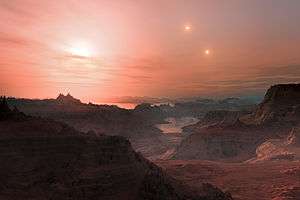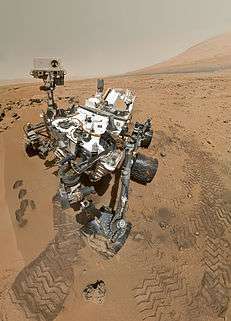Kepler-89
| Observation data Epoch Equinox | |
|---|---|
| Constellation | Cygnus |
| Right ascension | 19:49:20.0 |
| Declination | +41:53:28 |
| Apparent magnitude (V) | 12.4 |
| Characteristics | |
| Spectral type | F8 V |
| Astrometry | |
| Details | |
| Mass | 1.25 ± 0.04 M☉ |
| Radius | 1.656 R☉ |
| Temperature | 6116 K |
| Metallicity [Fe/H] | -0.01 ± 0.04 dex |
| Age | 3.9 ± 0.3 Gyr |
| Other designations | |
Kepler-89 | |
Kepler-89 is a star with four confirmed planets. Kepler-89 is a possible wide binary star.[1]
Planetary system
The discovery of four planets orbiting the star was announced October 2012 by analyzing data gathered by Kepler space telescope.[2] Follow-up radial velocity measurements confirmed the existence of Kepler-89d, indicating that Kepler-89d is slightly larger and more massive than Saturn.[3] In October 2013, other three planets were confirmed with Kepler-89c and Kepler-89e getting reasonable mass constraints. Transit-timing variations of the outermost planet suggest that additional planets or minor bodies are present in the system.[4]
In 2012, a partial transit of the second outermost planet by the outermost planet was reported. This was the first time a planet-planet transit in front of the star was detected.[5][2] This allowed to determine the mutual inclination of the planets d and e to be 1.15°.[4]
| Companion (in order from star) |
Mass | Semimajor axis (AU) |
Orbital period (days) |
Eccentricity | Inclination | Radius |
|---|---|---|---|---|---|---|
| b | <10.5 M⊕ | 0.05 | 3.7 | — | 89.3° | 0.13 RJ |
| c | 7.3-11.8 M⊕ | 0.099 | 10.4 | <0.1 | 88.36° | 0.31 RJ |
| d | 0.33±0.034 MJ | 0.165 | 22.3 | <0.1 | 89.871° | 0.83 RJ |
| e | 11.9-15.5 M⊕ | 0.298 | 54.3 | <0.1 | 89.76° | 0.49 RJ |
References
- ↑ Takahashi, Yasuhiro H.; Norio Narita; Teruyuki Hirano; Masayuki Kuzuhara; et al. (2013). "A Discovery of a Candidate Companion to a Transiting System KOI-94: A Direct Imaging Study for a Possibility of a False Positive". arXiv:1309.2559
 [EP astro-ph. EP].
[EP astro-ph. EP]. - 1 2 Teruyuki Hirano; Norio Narita; Bun'ei Sato; Takahashi, Yasuhiro H.; et al. (2012). "Planet-Planet Eclipse and the Rossiter-McLaughlin Effect of a Multiple Transiting System: Joint Analysis of the Subaru Spectroscopy and the Kepler Photometry". arXiv:1209.4362
 [astro-ph.EP].
[astro-ph.EP]. - ↑ Weiss, Lauren M.; Marcy, Geoffrey W.; Rowe, Jason F.; Howard, Andrew W.; Isaacson, Howard; Fortney, Jonathan J.; Miller, Neil; Demory, Brice-Olivier; Fischer, Debra A.; Adams, Elisabeth R.; Dupree, Andrea K.; Howell, Steve B.; Kolbl, Rea; Johnson, John Asher; Horch, Elliott P.; Everett, Mark E.; Fabrycky, Daniel C.; Seager, Sara (2013). "The Mass of KOI-94d and a Relation for Planet Radius, Mass, and Incident Flux". The Astrophysical Journal. 768: 14. arXiv:1303.2150
 . Bibcode:2013ApJ...768...14W. doi:10.1088/0004-637X/768/1/14.
. Bibcode:2013ApJ...768...14W. doi:10.1088/0004-637X/768/1/14. - 1 2 Masuda, Kento; Hirano, Teruyuki; Taruya, Atsushi; Nagasawa, Makiko; Suto, Yasushi (2013). "Characterization of the KOI-94 System with Transit Timing Variation Analysis: Implication for the Planet-Planet Eclipse". The Astrophysical Journal. 778 (2): 185–200. arXiv:1310.5771v2
 . Bibcode:2013ApJ...778..185M. doi:10.1088/0004-637X/778/2/185.
. Bibcode:2013ApJ...778..185M. doi:10.1088/0004-637X/778/2/185. - ↑ "First ever discovery of planet-planet eclipse | UTokyo Research". u-tokyo.ac.jp. Retrieved 2014-01-20.

